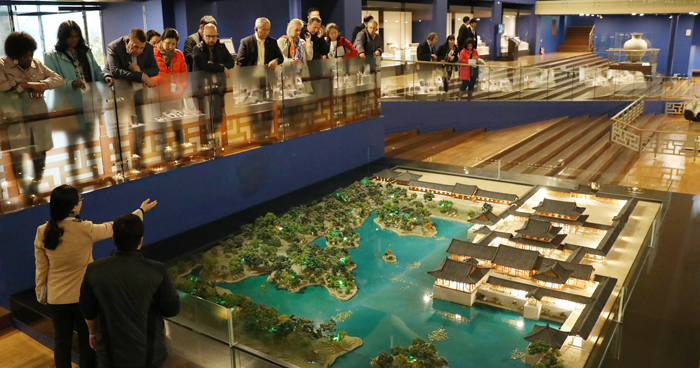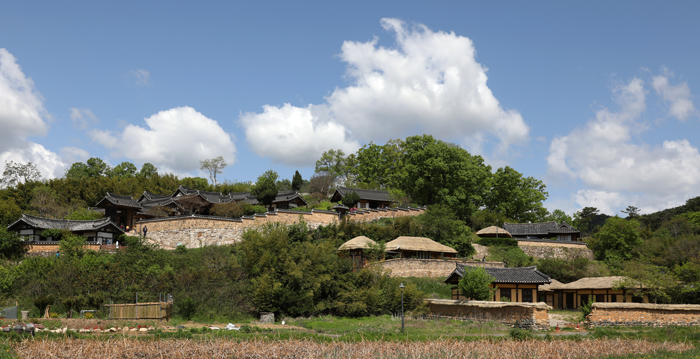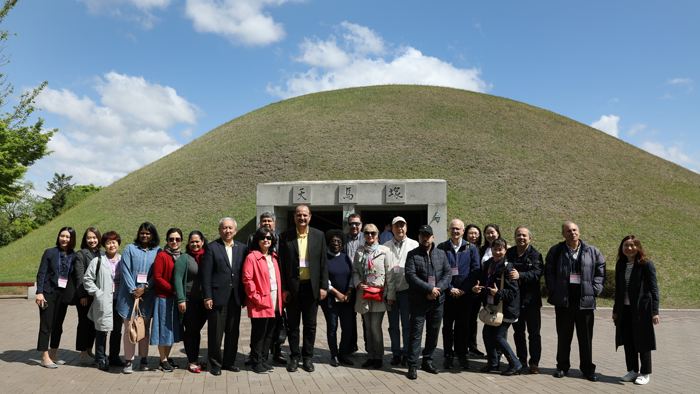
Foreign ambassadors in Korea and their families on April 26 are briefed on a Silla-era palace and the artificial lake Wolji during their visit to the Gyeongju National Museum in Gyeongju, Gyeongsangbuk-do Province.
By Yoon Sojung
Photos = Choi Taesoon
Foreign ambassadors in Korea from April 26-27 toured Gyeongju, Gyeongsangbuk-do Province, to learn more about UNESCO World Heritage Sites there to raise their understanding of Korea's Joseon Dynasty (1392–1910) and the ancient kingdom of Silla (57 B.C.-A.D. 935).
This excursion program was organized by the Korean Culture and Information Service (KOCIS) and the National Museum of Korea and targeted foreign ambassadors in Korea. More than 20 diplomatic officials from 11 countries participated.
KOCIS has run annual excursion programs to UNESCO World Heritage sites in Korea six times to raise understanding of Korean culture by foreign residents in the country. This Gyeongju trip was the first in this year's program for diplomats.
Participants in the Gyeongju trip first visited the Gyeongju National Museum and saw a variety of gold crowns and other ornaments and Buddhist-related remains from the Silla Kingdom. They also visited the Daereungwon Tomb Complex of Gyeongju Historical Sites, with most of them expressing keen interest in Silla tombs and related remains.
Thai Ambassador Singtong Lapisatepun was one of the most eager participants who asked many questions on the locations, sizes and excavation periods of the tombs, as well as the reason the gold crowns were bigger than the heads of the wearers. "Silla relics are beyond my expectations, and I've learned more about the kingdom," he said.
Ghanaian Ambassador Difie Agyarko Kusi also said, "Silla gold culture is fascinating," adding, "I used to hear about Korea when my husband worked for UNESCO to evaluate applications for World Heritage Sites around the globe, but now I should tell him that I came to Korea before him to see the actual UNESCO World Heritage sites."

Gyeongju Yangdong Village, designated a UNESCO World Heritage Site in 2010, is a clan-based area that has faithfully preserved the lifestyle and nature of the Joseon Dynasty era.
On the final leg of the trip, the group visited Gyeongju Yangdong Village, a place where traditional lifestyle and natural environment are preserved.
Along with Andong Hahoe Village, Gyeongju Yangdong Village was made a UNESCO World Heritage Site in 2010 for faithfully preserving the traditional culture and nature of the Joseon era.
The ambassadors enjoyed the village's peaceful and relaxing atmosphere and even exchanged friendly greetings with residents there. They also got firsthand experience in hammering rice cake batter (tteongme) and making the traditional bird-shaped wooden pole sotdae, or Korea's version of a totem pole.
Many of the diplomats said they discovered a connection between their home country's culture and Gyeongju, the capital of the ancient Silla Kingdom where Joseon culture is preserved.
Apostolic Nuncio to Korea and Mongolia Alfred Xuereb said, "Gyeongju, the capital city of an ancient kingdom and where Joseon culture remains, reminds me of my hometown, a small island called Malta, as we also have a megalithic temple site named Ggantija."
"It is such an enriching experience for me to better understand each other's culture."
Vietnamese Ambassador Nguyen Vu Tu said, "Through this trip, I have rediscovered another big common feature between Korea and Vietnam apart from national soccer coach Park Hang-seo, as both of us share the cultures of Buddhism and Confucianism."
"I wish that Vietnam can learn about Korea's effort to preserve historic remains."
KOCIS Director Kim Tae-hoon, who led this excursion, said, "I hope that this excursion can help diplomats get a more vivid and deeper understanding about Korean history and culture."
"KOCIS will strive to develop various programs for non-Koreans so that they can enjoy UNESCO Heritage Sites in Korea and both traditional and modern Korean culture."

Foreign ambassadors participating in a tour of UNESCO World Heritage Sites in Gyeongju, Gyeongsangbuk-do Province, on April 27 pose for photos in front of Cheonmachong Tomb while visiting the Daereungwon Tomb Complex of Gyeongju Historical Sites.
arete@korea.kr